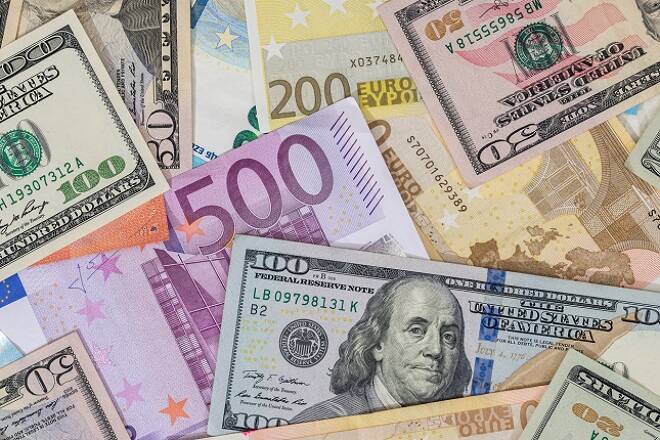Advertisement
Advertisement
The EUR/USD is Rejected Despite Accelerating Positive Momentum
By:
The EUR/USD moved higher but drifted off the highs of the day during the North American trading session after moving back down to support levels. The ECB
The EUR/USD moved higher but drifted off the highs of the day during the North American trading session after moving back down to support levels. The ECB Villeroy hinted of rate hikes next year which initially buoyed the currency pair. German and Eurozone GDP growth slowed down markedly in the first quarter which want not a surprise and despite efforts by the ECB to consider a phase out of QE, they will need continued stimulus to buoy their economies.
Technical
The EUR/USD came off the highs of the session forming a doji day where the open and close were at the same level reflecting indecision. The exchange rate was not able to hold up which might be the end of the brief dollar selloff. Support is seen near the 10-day moving average at 1.1933. Short term momentum has turned positive as the MACD (moving average convergence divergence) index generated a crossover buy signal. The fast stochastic generated a crossover buy signal in oversold territory which points to a higher exchange rate.
ECB’s Villeroy hints at rate hikes next year
Villeory said first interest rate hikes could come “some quarter, but not years”, after policy maker end their bond-buying program”. So far the ECB’s guidance only says that rates will remain on hold until “well past” the end of asset purchases. Villeory said that “as far as the first rate hike is concerned, we could give additional guidance on its timing – ‘well past’ meaning at least some quarters, but not years and its contingency on the inflation outlook”. “The time when our net asset purchases will end is approaching – and as I already said, whether it will be in September or in December is not a deep existential question”.
The ECB remains on course to phase out QE by the end of the year come what may, but this will only end the ongoing expansion of the central bank’s balance sheet. It still leaves officials with the task of scaling back support and returning policy back to normal. However, while rates are expected to be finally lifted next year, officials have turned cautious after a run of weak data. With that in mind, the majority of this week’s data is too backward looking to really change the overall outlook.
The main focus of this week on the data front is German ZEW investor confidence for May. This is the first reading without the noise of adverse weather conditions, an unusually high number of sick days, as well as calendar factors from the earlier timing of Easter this year. Another dip in the confidence reading would clearly put a dampener on the rate path going ahead, even if it won’t prevent the ECB from ending net asset purchases this year.
Norges Bank Governor Olsen signaled a rate hike
Norges Bank Governor Olsen signaled a rate hike, saying that the outlook shows that it will “soon be right to raise the key policy rate” and that is a “good sign.” The Norges Banks has been maintaining the deposit rate at a record low of 0.50% since March 2016, though Olsen has now put the prospect of a hike at the next policy review on June 21st. The Norges Bank’s previous guidance was for a tightening later this year, possibly in September. Olsen cited improving growth, declining unemployment and a robust global economy.
Fed’s Mester said she supports a gradual upward rate path
Fed’s Mester said she supports a gradual upward rate path, in comments at a Bank of France event. And she reiterated that in a CNBC interview, but also offered the funds rate may have to be pushed over the 3% mark. She’s a hawkish FOMC voter, and that view is in contrast to the non-voter Bullard, who thinks the Fed could be at neutral. It’s too soon to declare victory on attaining the 2% inflation goal, however, as the jump in the March PCE to 2% may not be sustained. Near-term monthly price readings have risen, she said, but some reflect higher commodity prices, where the strength is likely to be temporary due to base effects.
About the Author
David Beckerauthor
David Becker focuses his attention on various consulting and portfolio management activities at Fortuity LLC, where he currently provides oversight for a multimillion-dollar portfolio consisting of commodities, debt, equities, real estate, and more.
Advertisement
